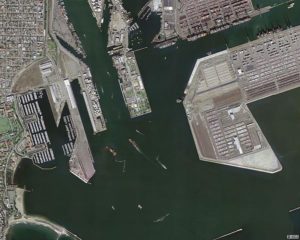Back on Aug. 6, 2013 I composed the “Legal challenge to proposed southern California-based rail yard project launched” Air Quality Matters blog post in which I reported: “In southern California … I understand that Burlington Northern Santa Fe Railway is proposing to build an expansive intermodal rail terminal that, if built, would sit on Port of Los Angeles terra firma. The proposed project’s name: The Southern California International Gateway (SCIG).”
Then on Apr. 3, 2016 in “Judge rules against SCIG – a ‘breather’ for Long Beach residents,” information in this post suggested that the project would not be moving forward.
I wrote: “The Natural Resources Defense Council (NRDC) in a prepared statement wrote: ‘The Natural Resources Defense Council filed a lawsuit today [June 7, 2013] in Los Angeles Superior Court on behalf of Harbor residents living within the shadow of the largest development on Port of Los Angeles property in more than a decade. The Plaintiffs contend the proposed Southern California International Gateway rail yard project violates the California Environmental Quality Act and the state and federal Civil Rights Acts, and will increase cancer rates, chances of children developing asthma, and add to chronic air pollution plaguing the region.’”

Further adding: “On the lawsuit development front in ‘Judge Backs City of Long Beach in Rail Yard Project Suit; Port of LA & BNSF Sent Back to Drawing Board,’ what staff at Longbeachize reported was that the judge presiding over the case – Superior Court Judge Barry P. Goode – found in the plaintiff’s favor, essentially ruling that the project environmental analysis performed was inadequate.”
More on this, at the time and in response, the BNSF Railway in an Apr. 8, 2016 press release issued the following:
“The eight-year long environmental review was exhaustive, with a Draft Environmental Impact Report (EIR), Recirculated Draft EIR and Final EIR totaling more than 5,000 pages and an administrative record of more than 200,000 pages. As the court acknowledged in its ruling, ‘the EIR is an impressive piece of work. It is clear that a great deal of careful thought has been given to the environmental impacts of the project.’
“BNSF was ready to invest $500 million in the regional economy with this facility, going well beyond legal requirements, including $100 million in green technologies such as electric cranes, ultra-low emission locomotives and solar energy. The company also made significant changes to the project’s design and operations in direct response to community feedback. In addition, BNSF committed to allow only clean trucks on designated industrial routes with GPS tracking, support for zero or near-zero emissions technologies, a soundwall, intensive landscaping, a local jobs training program and priority hiring for new jobs to qualified local job applicants.”
What I have now learned is that the project has received limited California Environmental Quality Act approval regarding “the project environmental analysis,” and, regarding the proposed project environmental impact report or EIR, the one outstanding issue remaining centers around certain air pollution impacts still needing addressing, apparently.
It is unclear at this time whether the case will be appealed to a higher court.
Meanwhile, from the same aforementioned press release the BNSF Railway describes the proposed project thus:

I plan on providing further updates when information is available.
Stay tuned.
Image (upper): United States Geological Survey
This post was last revised on May 10, 2020 @ 10:37 a.m. Pacific Daylight Time.
– Alan Kandel

This case was appealed to the California Supreme Court, and the Supreme Court declined to hear the appeal.
— Robert Frampton
Thank you for providing the updated information.
I am trying to find out from Port of LA what is the current status of the SCIG. I sent this query to the Port:
.1) What is the next procedural step in the SCIG project? Do you await the Appellate Court’s final ruling and when is it expected (or have you received it)?
.2) What revisions will BNSF and POLA be making to the final EIR to satisfy the Appellate Court? And what is the timeline for those revisions? Then do you get final court certification of the final (revised) EIR?
.3) When is anticipated construction start date for the SCIG infrastructure?
I was thinking the same thing myself as to when construction on the SCIG would get underway.
Just to reiterate (and as written above): “The Southern California International Gateway (SCIG) would be located on an existing industrial site between the Terminal Island Freeway, Sepulveda Boulevard and Pacific Coast Highway with direct access to the Alameda Corridor. Currently, much of the freight transported from the port to other destinations by rail must travel by truck to rail yards near downtown Los Angeles more than 24 miles away. A new intermodal facility within four miles of the ports would allow trucks loaded with cargo containers from ships to travel just a short distance before transferring the containers to rail cars that would then travel through the Alameda Corridor and on to destinations throughout the country.” (This quote from “Southern California International Gateway (SCIG) Ruling a Major Loss for Southern California Economy, Community and Port Competitiveness” http://www.bnsf.com/news-media/news-releases/SCIG-ruling.html – the original source).
If this turns out to be the case, my hope is a mandate stipulating that nothing other than zero-emissions tractors be used in the ship-to-train part of the container transfer process is not only put into effect, but strictly adhered to.